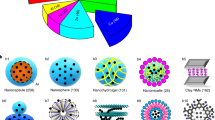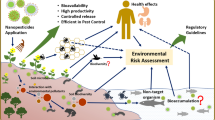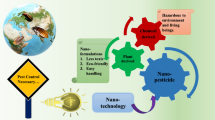Abstract
Plant pest and diseases control are commonly managed with conventional pesticides and chemicals that have shown a negative environmental impact. Thus, interest in efficient, safe, and green pesticide formulations has been growing to alleviate environmental and human toxicity risks. Nanopesticides, derived from recent advances in technology, have shown better-targeted pesticide delivery, and they could be eco-friendly and applied to sustainable agriculture. The use of nanotechnology in plant protection is a promising interdisciplinary approach that includes nanomaterials-based pesticides. Recently, nanopesticides have shown a notable effect on plant pest and disease control. Additionally, they answered to challenges of reducing costs and volume of pesticides while preciseness, crop yield, and biodegradability increased continuously. Several nanomaterials were evaluated and showed great potential in creating novel formulations. Otherwise, the effect of these products on nontarget species that exist in the same ecosystem of the target pathogen needs to be studied more. The nanopesticides of biological origin named nano-biopesticides or green synthesized nanopesticides could be, as the best alternative, the new trend combining nanotechnology and biological solutions, putting forward great findings for plant protection. The present review summarizes the currently used nanoparticles as pesticide formulations. Furthermore, the future challenges of this fast-growing and promising approach to sustainable agriculture are exposed. Finally, the current situation and the future of nano-biopesticides are discussed.
Similar content being viewed by others
References
Abas Shah M, Wani SH, Akhtar AK (2016) Nanotechnology and insecticidal formulations. J Food Bioeng Nanoproc 1(3):285–310
Abdelmalek GMA, Salaheldin TA (2016) Silver nanoparticles as a potent fungicide for Citrus phytopathogenic fungi. J Nanomed Res 3(5):00065
Adak T, Kumar J, Dey D, Shakil NA, Walia S (2012) Residue and bio-efficacy evaluation of controlled release formulations of imidacloprid against pests in soybean (Glycine max). J Environ Sci Health B 47:226–231
Alfadul SM, Altahir OS, Khan MA (2017) Application of nanotechnology in the field of food production. Acad J Sci Res 5(7):143–154
Ali EO, Shakil NA, Rana VS, Sarkar DJ, Majumder S, Kaushik P, Singh BB, Kumar J (2017) Antifungal activity of nano emulsions of neem and citronella oils against phytopathogenic fungi, Rhizoctonia solani and Sclerotium rolfsii. Ind Crop Prod 108:379–387
Balaji DS, Basavaraja S, Deshpande R, Mahesh DB, Prabhakar BK, Venkataraman A (2009) Extracellular biosynthesis of functionalized silver nanoparticles by strains of Cladosporium cladosporioides fungus. Colloids Surf B 68:88–92
Bhan S, Mohan L, Srivastava CN (2018) Nanopesticides: a recent novel ecofriendly approach in insect pest management. J Entomol Res 42(2):263–270
Bhattacharyya A, Bhaumik A, Rani PU, Mandal S, Epidi TT (2010) Nano-particles—a recent approach to insect pest control. Afr J Biotechnol 9:3489–3493
Bhattacharyya A, Duraisamy P, Govindarajan M, Buhroo AA, Prasad R (2016) Chapter 15 nano-biofungicides: emerging trend in insect pest control. In: Prasad R (ed) Advances and applications through fungal nanobiotechnology fungal biology. Springer, Berlin. https://doi.org/10.1007/978-3-319-42990-8_15
Chin CP, Wu HS, Shaw S, Wang SS (2011) New approach to pesticide delivery using nanosuspensions: research and applications. Ind Eng Chem Res 50(12):7637–7643. https://doi.org/10.1021/ie2001007
Choudhury R, Majumder M, RoyDN BS, Misra TK (2016) Phytotoxicity of Ag nanoparticles prepared by biogenic and chemical methods. Int Nano Lett 6:153. https://doi.org/10.1007/s40089-016-0181-z
Devi TP, Kulanthaivel S, Kamil D, Borah JL, Prabhakaran N, Srinivasa N (2013) Biosynthesis of silver nanoparticles from Trichoderma species. Ind J Exp Biol 51:543–547
Dimetry NZ, El-Wakeil N, Hussein H (2019) Essential oils development through nanoparticles for managing stored product insect pests. Trends Appl Sci Res 14:142–159
Elumalai K, Velmurugan S, Ravi S, Kathiravan V, Raj GA (2015) Bio-approach: plant mediated synthesis of ZnO nanoparticles and their catalytic reduction of methylene blue and antimicrobial activity. Adv Powder Technol 26:1639–1651
Fateixa S, Neves MC, Almeida A, Oliveira J, Trindade T (2009) Anti-fungal activity of SiO2/Ag2S nanocomposites against Aspergillus niger. Colloids Surf B 74:304–308
Feng BH, Peng LF (2012) Synthesis and characterization of carboxymethyl chitosan carrying ricinoleic functions as an emulsifier for azadirachtin. Carbohydr Polym 88:576–582
Frandsen MV, Pedersen MS, Zellweger M, Gouin S, Roorda SD, Phan TQC (2010) Piperonyl butoxide and deltamethrin containing insecticidal polymer matrix comprising HDPE and LDPE. Patent number WO 2010015256 A2 20100211
Ghormade V, Deshpande MV, Panikar KM (2011) Perspectives for nano-biotechnology enabled protection and nutrition of plants. Biotechnol Adv 29:792–803
Gopinath V, Velusamy P (2013) Extracellular biosynthesis of silver nanoparticles using Bacillus sp. GP-23 and evaluation of their antifungal activity towards Fusarium oxysporum. Spectrochim Acta A Mol Biomol Spectrosc 106:170–174
Grillo R, Fraceto LF, Amorim MJB, Scott-Fordsmand JJ, Schoonjans R, Chaudhry Q (2021) Ecotoxicological and regulatory aspects of environmental sustainability of nanopesticides. J Hazard Mater 404:124148. https://doi.org/10.1016/j.jhazmat.2020.124148
Guan H, Chi D, Yu J, Li X (2008) A novel photodegradable insecticide: preparation, characterization and properties evaluation of nanoImidacloprid. Pestic Biochem Physiol 92(2):83–91
Hayles J, Johnson L, Worthley C, Losic D (2017) Nanopesticides: a review of current research and perspectives. New Pestic Soil Sens. https://doi.org/10.1016/B978-0-12-804299-1.00006-0
Hazra DK (2017) Nano-formulations: high definition liquid engineering of pesticides for advanced crop protection in agriculture. Adv Plants Agric Res 6(3):56–57
He X, Deng H, Hwang HM (2019) The current application of nanotechnology in food and agriculture. J Food Drug Anal 27(1):1–21. https://doi.org/10.1016/j.jfda.2018.12.002
Horbach R, Navarro-Quesada AR, Knogge W, Deising HB (2011) When and how to kill a plant cell: infection strategies of plant pathogenic fungi. J Plant Physiol 168:51–62
Huang W, Wang C, Duan H, Bi Y, Wu D, Du J, Yu H (2018) Synergistic antifungal effect of biosynthesized silver nanoparticles combined with fungicides. Int J Agric Biol 20:1225–1229
Hwang IC, Kim TH, Bang SH, Kim KS, Kwon HR, Seo MJ, YuYM, (2011) Insecticidal effect of controlled release formulations of etofenprox based on nano-bio technique. J Fac Agric Kyushu Univ 56:33–40
Iavicoli I, Leso V, Beezhold DH, Shvedova AA (2017) Nanotechnology in agriculture: opportunities, toxicological implications, and occupational risks. Toxicol Appl Pharmacol 329:96–111
Kah M, Hofmann T (2014) Nanopesticide research: current trends and future priorities. Environ Int 63:224–235. https://doi.org/10.1016/j.envint.2013.11.015
Kah M, Beulke S, Tiede K, Hofmann T (2013) Nanopesticides: state of knowledge, environmental fate, and exposure modeling. Crit Rev Environ Sci Technol. https://doi.org/10.1080/10643389.2012.671750
Kah M, Weniger AK, Hofmann T (2016) Impacts of (nano) formulations on the fate of an insecticide in soil and consequences for environmental exposure assessment. Environ Sci Technol 50(20):10960–10967. https://doi.org/10.1021/acs.est.6b02477
Kalimuthu K, Babu RS, Venkataraman D, Bilal M, Gurunathan S (2008) Biosynthesis of silver nanocrystals by Bacillus licheniformis. Colloids Surf B 65:150–153
Khan MR, Rizvi TF (2014) Nanotechnology: scope and application in plant disease management. Plant Pathol J 13:214–231
Kookana RS, Boxall ABA, Reeves PT, Ashauer R et al (2014) Nanopesticides: guiding principles for regulatory evaluation of environmental risks. J Agric Food Chem. https://doi.org/10.1021/jf500232f
Korbekandi H, Iravani S, Abbasi S (2012) Optimization of biological synthesis of silver nanoparticles using Lactobacillus casei subsp. casei. J Chem Technol Biotechnol 87(7):932–937
Kumar VS, Preeti S, Dinesh C, Usha R, Saundarya K, Praveen S (2013) Formulation and evaluation of effect of different stabilizer at nanosuspension of satranidazole. World J Pharm Pharm Sci 3(2):1367–1377
Lahuf AA, Kareem AA, Al-Sweedi AM, Alfarttoosi HA (2019) Evaluation the potential of indigenous biocontrol agent Trichoderma harzianum and its interactive effect with nanosized ZnO particles against the sunflower damping-off pathogen, Rhizoctonia solani. IOP Conf Ser Earth Environ Sci 365:012033
Lai F, Wissing SA, Müller RH, Fadda AM (2006) Artemisia arborescens L. essential oil–loaded solid lipid nanoparticles for potential agricultural application: preparation and characterization. AAPS Pharm Sci Tech 7:1–9
Lamsal K, Kim SW, Jung JH, Kim YS, Kim KS, Lee YS (2011) Inhibition effects of silver nanoparticles against powdery mildews on cucumber and pumpkin. Mycobiol 39:26–32
Lao SB, Zhang ZX, Xu HH, Jiang GB (2010) Novel amphiphilic chitosan derivatives: synthesis, characterization and micellar solubilization of rotenone. Carbohydr Polym 82:1136–1142
Liu Y, Tong Z, Prud’homme RK (2008) Stabilized polymeric nanoparticles for controlled and efficient release of bifenthrin. Pestic Manag Sci 64:808–812. https://doi.org/10.1002/ps.1566
Loha KM, Shakil NA, Kumar J, Singh MK, Srivastava C (2012) Bio-efficacy evaluation of nanoformulations of β-cyfluthrin against Callosobruchus maculatus (Coleoptera: Bruchidae). J Environ Sci Health B47(7):687–691. https://doi.org/10.1080/03601234.2012.669254
McClements DJ, Xiao H (2017) Is nano safe in foods? Establishing the factors impacting the gastrointestinal fate and toxicity of organic and inorganic food-grade nanoparticles. NPJ Sci Food 1:6. https://doi.org/10.1038/s41538-017-0005-1
Mishra S, Singh BR, Naqvi AH, Singh HB (2017) Potential of biosynthesized silver nanoparticles using Stenotrophomonas sp. BHU-S7 (MTCC 5978) for management of soil-borne and foliar phytopathogens. Sci Rep 27(7):45154
Mukhopadhyay SS (2014) Nanotechnology in agriculture: prospects and constraints. Nanotechnol Sci Appl 7:63–71
Nair R, Varghese SH, Nair BG, Maekawa T, Yoshida Y, Kumar DS (2010) Nanoparticulate material delivery to plants. Plant Sci 179:154–163
Nuruzzaman M, Rahman MM, Liu Y, Naidu R (2016) Nanoencapsulation, nano-guard for pesticides: a new window for safe application. J Agric Food Chem 64:1447–1483. https://doi.org/10.1021/acs.jafc.5b05214
Pan ZZ, Cui C, Cui HX et al (2014) Progress on pesticide nanosuspension and its preparation methods. Chin J Pestic Sci 16(6):635–643
Patel VR, Agrawal YK (2011) Nanosuspension: an approach to enhance solubility of drugs. J Adv Pharm Technol Res 2:81–87
Patel N, Desai P, Patel N, Jha A, Gautam HK (2014) Agronanotechnology for plant fungal disease management: a review. Int J Curr Microbiol Appl Sci 3(10):71–84
Prabhu D, Arulvasu C, Babu G, Manikandan R, Srinivasan P (2013) Biologically synthesized green silver nanoparticles from leaf extract of Vitex negundo L. induce growth-inhibitory effect on human colon cancer cell line HCT15. Process Biochem 48:317–324
Prasad R, Pandey R, Barman I (2016) Engineering tailored nanoparticles with microbes: quo vadis? Wiley Interdiscip Rev Nanomed Nanobiotechnol 8(2):316–330
Prasad R, Bhattacharyya A, Nguyen QD (2017) Nanotechnology in sustainable agriculture: recent developments, challenges, and perspectives. Front Microbiol 8:1014. https://doi.org/10.3389/fmicb.2017.01014
Qian K, Shi T, Tang T, Zhang S, Liu X, Cao Y (2011) Preparation and characterization of nano-sized calcium carbonate as controlled release pesticide carrier for validamycin against Rhizoctonia solani. Microchim Acta 173:51–57
Rafique M, Sadaf I, Rafique MS, Tahir MB (2017) A review on green synthesis of silver nanoparticles and their applications. Artif Cells Nanomed Biotechnol 45:1272–1291
Ragaei M, Sabry AKH (2014) Nanotechnology for insect pest control. Int J Sci Environ Technol 3:528–545
Rai SK, Alistair BAB, Philip TR, Roman A et al (2014) Nanopesticides: guiding principles for regulatory evaluation of environmental risks. J Agric Food Chem 62(19):4227–4240
Ramadass M, Thiagarajan P (2017) Effective pesticide nano formulations and their bacterial degradation. IOP Conf Ser Mater Sci Eng 263:022050
Saharan V, Mehrotra A, Khatik R, Rawal P, Sharma S, Pal A (2013) Synthesis of chitosan based nanoparticles and their in vitro evaluation against phytopathogenic fungi. Int J Biol Macromol 62:677–683
Sayed AMM, Kim S, Behle RW (2017) Characterisation of silver nanoparticles synthesised by Bacillus thuringiensis as a nanobiopesticide for insect pest control. Biocontrol Sci Tech. https://doi.org/10.1080/09583157.2017.1397597
Scheringer M, Praetorius A, Goldberg ES (2014) Chapter 3: Environmental fate and exposure modeling of nanomaterials. In: Jamie RL, Eugenia VJ (eds) Frontiers of nanoscience, vol 7. Elsevier, Amsterdam, pp 89–125
Sekhon BS (2014) Nanotechnology in agri-food production: an overview. Nanotechnol Sci Appl 7:31–53
Seo YC, Cho JS, Lee TW, Kim SI, Yoom WB, Lee HY (2011) Enhancement of antifungal activity of anthracnose in pepper by nanoparticles of thiamine di-lauryl sulfate. Korean J Med Crop Sci 19:198–204
Singh B, Sharma DK, Kumar R, Gupta A (2009) Controlled release of the fungicide thiram from starch–alginate–clay based formulation. Appl Clay Sci 45:76–82
Singh R, Shedbalkar UU, Wadhwani SA, Chopade BA (2015) Bacteriagenic silver nanoparticles: synthesis, mechanism, and applications. Appl Microbiol Biotechnol 99:4579–4593
Song S, Liu X, Jiang J, Qian Y, Zhang N, Wu Q (2009) Stability of triazophos in self-nanoemulsifying pesticide delivery system. Colloids Surf A 350:57–62. https://doi.org/10.1016/j.colsurfa.2009.08.034
Stamatis N, Helac D, Konstantinou I (2010) Occurrence and removal of fungicides in municipal sewage treatment plant. J Hazard Mater 175:829–835
Surendra KD (2019) The new integrated pest management paradigm for the modern age. J Integr Pest Manag 10(1):1–9
Vandana Deshpande MV, Kishore Paknikar M (2011) Perspectives for nano-biotechnology enabled protection and nutrition of plants. Biotechnol Adv 29:792–803
Vimala Devi PS, Duraimurugan P, Chandrika KSVP, Gayatri B, Prasad RD (2019) Nanobiopesticides for crop protection. In: Prasad R, Abd-Elsalam K (eds) Nanobiotechnology applications in plant protection. nanotechnology in the life sciences. Springer, Cham
Worrall EA, Hamid A, Mody KT, Mitter N, Pappu HR (2018) Nanotechnology for plant disease management: a review. Agronomy 8(285):1–24
Yang W, Peters JI, Williams RO (2008) Inhaled nanoparticles—a current review. Int J Pharm 356:239–247
Zahir AA, Bagavan A, Kamaraj C, Elango G, Rahuman AA (2012) Efficacy of plant-mediated synthesized silver nanoparticles against Sitophilus oryzae. J Biopestic 5:95–102
Zeng H, Li X, Zhang G, Dong J (2008) Preparation and characterization of beta cypermethrin nanosuspensions by diluting O/W microemulsions. J Dispers Sci Technol 29(3):358–361
Author information
Authors and Affiliations
Corresponding author
Ethics declarations
Conflict of interest
The authors declare that they have no conflicts of interest.
Ethical approval
This article does not contain any studies with human participants or animals performed by any of the authors.
Additional information
Responsible Editor: Mohamed Ksibi .
Rights and permissions
About this article
Cite this article
Hajji-Hedfi, L., Chhipa, H. Nano-based pesticides: challenges for pest and disease management. Euro-Mediterr J Environ Integr 6, 69 (2021). https://doi.org/10.1007/s41207-021-00279-y
Received:
Accepted:
Published:
DOI: https://doi.org/10.1007/s41207-021-00279-y




